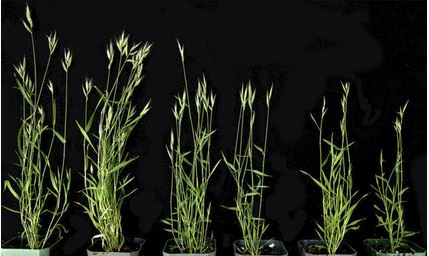Washington State, USA
May 21, 2020

Karen Sanguinet, at a WSU Pullman greenhouse, partnered in the research.
A team of Washington State University scientists discovered how a little-understood plant protein guides development of tiny cellular structures that regulate the flow of sap from roots to shoots, revealing a potential way to help crops survive in a changing climate.
Detailed earlier this year in the journal New Phytologist, researchers at WSU’s Institute of Biological Chemistry (IBC) teamed up with molecular biologists and crop scientists at WSU, Princeton University, and the Université Côte d’Azur to investigate a protein called MAP20.
MAP20 was believed to play a role in producing cellulose, a key component of cell walls, but its physiological function was a mystery. Investigating MAP20 using Brachypodium, a model grass related to wheat, IBC biologist Andrei Smertenko partnered with Karen Sanguinet, a molecular physiologist in WSU’s Department of Crop and Soil Sciences. They designed experiments testing the protein’s function using genetics, cellular structure analysis, cell biology and biochemistry.
An important clue came from where the protein is chiefly found in plants—in the developing xylem, the system of micro-capillaries that moves water and nutrients up from the roots. Specifically, MAP20 centers on tiny, specialized cell structures called pits—microscopic openings with thin membranes that allow fluids to move from cell to cell.
Pit architecture is laid down in the early stages of plant organ development. Cells that form the vasculature gradually die and become hollow tubes. Sap moves between the dead cells through pits, and its flow depends on pit size and thickness of the pit membrane, a thin layer of carbohydrates and proteins.
The team showed that MAP20 interacts with the network of protein nanotubes called microtubules that determine the size of pits.

WSU scientists experimented with model grasses to reveal the function of an important plant protein called MAP20. Plants with lower levels of MAP20, at right, were smaller, with lower yields and greater susceptibility to drought (WSU photo).
Glenn Turner, a researcher in Smertenko’s group in the IBC, used an electron microscope to measure the thickness of pit membranes in both MAP20 mutants and control plants.
“We found that mutants had significantly thinner pit membranes,” he said, pointing to MAP20’s role in drought resiliency.
“Pit architecture plays an important role in plant response to drought,” Smertenko said. “It can prevent blockages called embolisms that form in the vascular cells under drought conditions. When soil moisture dries out, the xylem micro-capillaries can fill with air bubbles that prevent fluid from moving. Think of it as a highway: if you get a blockage, traffic stops.”
“We asked a question: can absence of MAP20 affect drought recovery?” said lead author Tetyana Smertenko, a postdoctoral researcher in IBC. “We showed that the survival rate of plants lacking MAP20 was significantly lower. Knockdown of MAP20 affected development of the vasculature system, lowers yield, and increases susceptibility to drought.”
Under normal environmental conditions, plants make larger pits with thinner pit membranes to take advantage of plentiful water. But in response to drought, MAP20 helps to make smaller pits with thicker membranes, preventing embolism.
“If a plant finds itself in an arid climate during its early development, it adjusts the vascular system structure for that climate,” explained Andrei Smertenko. “This is when MAP20 kicks in” making smaller pits with thicker membranes. “Water movement through the plant is reduced, and it may not have a great yield, but it’ll be able to complete its life cycle.”
“MAP20 is a node between development and environmental regulation,” Sanguinet said. “It’s like a little switch that changes the size of pits and pit membranes. It wasn’t what we were expecting.”
Now that scientists know more about how MAP20 functions, they can learn how it is regulated in other, staple crops, such as wheat.
“This could help us breed crops with optimal vascular architecture, ensuring better yields in drier climates,” Smertenko said.

WSU scientist Andrei Smertenko, in his WSU Pullman lab, co-led efforts to understand MAP20’s role in plant development.
“To feed a changing world, we need to examine all aspects of plant growth and development,” Sanguinet said. “We can’t change the weather, but we may be able to control the way plants recover from stress. Understanding the role of MAP20 helps us protect the crops of the future.”
Additional partners in the research included Deirdre Fahy at WSU’s Institute of Biological Chemistry; Rhoda Brew-Appiah, a post-doctoral researcher with WSU’s Department of Crop and Soil Sciences; Raymundo Alfaro-Aco, scientist at Princeton University; and Janice de Almeida Engler, scientist at the Université Côte d’Azur.
The project was funded in part by grants from the U.S. Department of Agriculture, the National Science Foundation, WSU’s Orville A. Vogel Wheat Research Fund, and WSU startup funding.